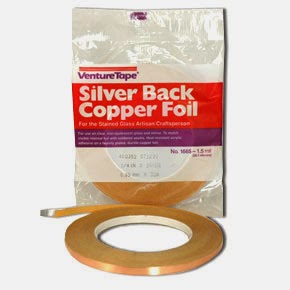As stained glass gained in popularity and consumers became more conscious of little details that detracted from the aesthetic value of the finished product, manufacturers began to make copper foils with different colored backing.
But, why are different colored backs needed or even wanted?
The answer is quite simple. To create more attractive looking seams in the finished product.
For opaque stained glass, the standard backed copper foil (front and back) works just fine. This is because the back of the foil cannot be seen through the glass when the solder seam is completed.
However, with clear glass, transparent stained glass or beveled glass patterns; the back of the foil that is used in the project's construction can be easily seen when looking through the edge of the glass into the seam.
When the back color of the foil does not match the natural color of the solder or when the color of the patina you use is not copper colored, the back color of the foil used can be distracting and look unsightly on the finished project.
Suncatchers are especially susceptible to unsightly looking seams.
To handle the problem, manufacturers started making silver and black baked foils for the stained
glass market.
Now when you create a beveled glass design or incorporate one into a suncatcher or glass panel, and apply a black patina to your project; you can use a black backed foil so the finished seams match the color of the patina in your project.
If you are making a project and leaving the solder without applying a patina, you can use a silver packed foil to match the silver solder seams. If you want to use a copper patina, use regular copper foil, etc.
There is no true brass color patina, but there is a brass back foil that is most often used with clear glass that will be brass plated after soldering. Brass backed foil is not often soldered.
Occasionally you may want to avoid tinning a project that is foiled with copper tape, to make it silver.
In these instances you can use a double silvered tape. This is a specialty tape that is silvered on both sides and is useful when you have edges that you are not soldering but that you want to make look silver.
Another specialty foil that comes in different colored backing is a scalloped edge foil called Wave Foil.
As the name implies, the foil has a wavy pattern on one side and is straight on the other side.
It is normally about 5/16" wide and is also made in a copper, black or silver back.
Scalloped edge foils can be used to add unique detail and create interest in your stained glass projects.
You can foil one or both sides of a seam, line up the scallops to create a continuous "wave" or offset the scallops, or you can use the foil as an overlay to a stained glass project.
Used as an overlay, apply the foil so the dips in the scallops on the surface of the glass line up with or cover the straight edge that would normally be wrapped around the underside of the glass.
I'm sure you can find other interesting uses for scalloped or "wave" foils that can enhance the look of your stained glass projects.
To sum it up, there are now five types of foils manufactured for use in the stained glass industry.
- Standard copper foil with copper back
- Copper foil with silver back
- Copper foil with black back
- Double silver foil (both sides are silver)
- Actual Brass foil (brass both sides)


